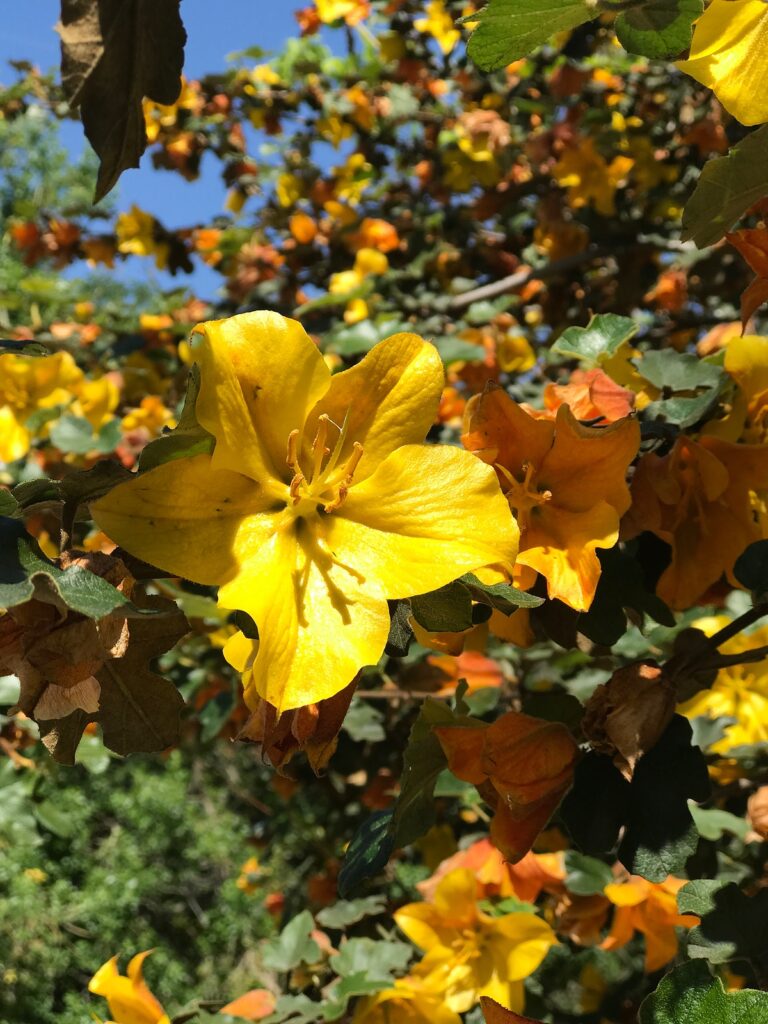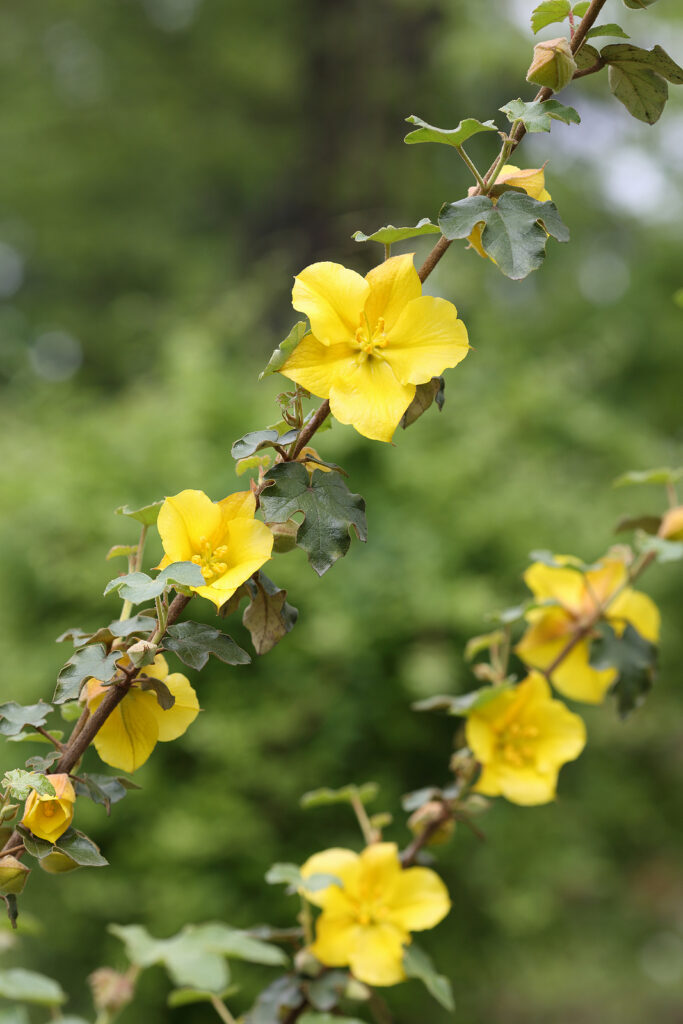Fremontodendron–commonly called flannel bush–is a fast-growing irregularly shaped evergreen shrub with brilliant yellow or orange saucerlike flowers in spring. Fremontodendron has dark green leathery leaves that are grayish and felt-like underneath.
Fremontodendron, also called Fremontia, is drought-tolerant once established. It is a good choice for native western gardens. It should be planted where the spring flower displant can be seen.
Fremontodendron are shallow-rooted and should be staked while young. Fremontodendron is short-lived, about ten to twenty years.
Fremontodendron is a genus of just two species. Fremontodendron is native to dry woods and mountainsides in the southwest United States and northern Mexico.

Get to know Fremontodendron
- Plant type: Evergreen shrub or small tree
- Growing zones and range: Zones 9 and 10
- Hardiness: Can tolerate below freezing temperatures for a short period
- Height and width: Grow 6 to 10 feet (2-6m) tall and 12 to 20 feet (4m-6m wide depending on the variety.
- Foliage: Rounded or lobed leathery dark green leaves, softly hairy beneath; shoots are densely hairy.
- Flowers: Showy briliant yellow or orange saucer-like flowers
- Fruit: Flowers are followed by persistent conical seed capsules covered with bristly, rust-colored hairs; the seed capsules will irritate skin.
- Bloom time: Spring
- Uses: Shrub or mixed border; specimen plant; grow against a wall
- Common name: Flannel bush
- Botanical name: Fremontodendron
- Family name: Sterculiaceae
- Origin: Dry canyons of Southwest United States and Mexico
Where to plant Fremontodendron
- Plant Fremontodendron in full sun.
- Grow Fremontodendron in moderately fertile, dry but well-drained neutral or alkaline soil.
- Fremontodendron is completely drought tolerant when established; it will accept occasional water during their normally dry period in summer only if drainage is excellent.
- Shelter Fremontodendron from cold, drying winds.
- Fremontodendron tend to be short-lived.
When to plant Fremontodendron
- Plant container-grown Fremontodendron in spring or autumn.
Planting and spacing Fremontodendron
- Space Fremontodendron 12 to 20 feet apart.
How to water and feed Fremontodendron
- Water Fremontodendron unitl established; once established it will tolerate very little summer water.
- Fertilize Fremontodendron light wiht an all-purose organic fertilizer in spring.
Fremontodendron care
- Fremontodendron has shallow roots so plants should be staked when young.
- Fremontodendron can be wall trained to show off its handsome foliage and flowers.
- Pruning is minimal except for wall-trained specimens.
Fremontodendron pests and diseases
- Fremontodendron is susceptible to root rot and stem rot in containers.
- Fremontodendron can be attacked by scale insects.

Fremontodendron propagation
- Sow seeds in warm soil in spring. Soak seeds overnight before sowing.
- Root greenwood cuttins in early summer or semi-ripe cuttings in late summer.
Fremontodendron varieties to grow
- Fremontodoendron. ‘California Glory’. Hybrid between F. californicum and F. mexicanum. Upright then spreading evergreen shrub with dark lobed leaves; flowers to 3 inches across, rich yellow inside, tinged red outside; heavy bloomer over long a period; grows to 20 feet tall and 12 feet wide.
- F. californicum. Common flannel bush. Upright evergreen or semi-evergreen with round dark green leaves; shallow saucer-shaped lemon yellow, 1-1 ½-inch flowers that tend to bloom all at once; roundish unlobed or three-lobed leaves, 1 inch long; grows to 20 feet tall and 12 feet wide.
- F. ‘Ken Taylor’. Spreading evergreen shrube with round or lobe dark green leaves with shallow, orange-yellow flower to 6 feet tall.
- F. mexicanum. Southern flannel bush. Upright evergreen or semievergreen shrubs grows to 20 feet tall and 12 feet wide; brilliant orange-tinted blossoms to 2 ½ inches across; blooms less profusely than F. californicum, but flowers appear over a longer period.
- F. ‘San Gabriel’. Resembles ‘California Glory’ with deeply cut (maplelike) leaves.















